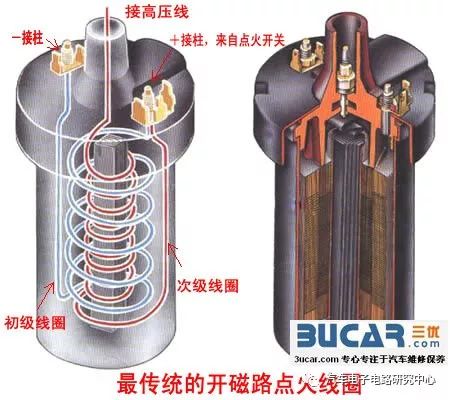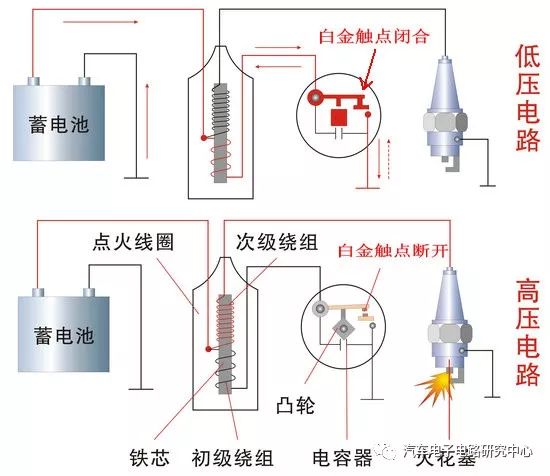The role of the engine ignition system: According to the sequence of work done by the engine, a DC high voltage with sufficient energy for the spark plug is supplied at a prescribed timing to generate sparks between the two electrodes to ignite the mixture so that the engine can perform work. Breakdown voltage should be able to reach 15 ~ 20kV. In the development of the ignition system, it has experienced three types of ignition systems: traditional platinum ignition systems, electric ignition systems, and computer-controlled ignition systems (ie, electronically controlled ignition systems). The composition of the various ignition systems varies, but the basic principles are the same. No matter what kind of ignition system, two most basic components are needed: ignition coil and spark plug. The ignition coil is used to convert 12V low voltage direct current to high voltage direct current of 15-20kV. Spark plugs are used to introduce the high voltage generated by the ignition coil into the combustion chamber, creating sparks that ignite the mixture. Ignition coil structure diagram How does the ignition coil work? The ignition coil is equivalent to a transformer with two coils: the primary coil and the secondary coil. The primary coil and the secondary coil have a common termination power supply positive pole (12V). The other end of the primary coil is controlled by a control switch. The control switch is first closed and the primary coil is energized to generate a magnetic field. After that, the control switch is opened and the primary coil is powered off. When the magnetic field disappears, a high voltage of 15KV-20KV is induced at the secondary. After the high piezoelectric action acts on the spark plug, a spark is generated across the electrode gap of the spark plug, thereby igniting the air-fuel mixture in the cylinder. From mechanical platinum ignition, electronic ignition to microcomputer control ignition, the difference is mainly in three points: (1) Who controls the energization and de-energization of the primary coil of the ignition coil (2) How to adjust the ignition timing automatically (3) Because the engine has multiple cylinders, how the high voltage of the ignition coil is distributed to each cylinder in the order of engine operation The composition of the traditional platinum ignition system: Components of conventional mechanical ignition systems The components of traditional mechanical ignition systems include power supplies, ignition switches, ignition coils, distributors, spark plugs, and high-voltage wires (high-voltage lines). Traditional mechanical ignition system connection schematic The ignition coil is actually a transformer, mainly composed of a primary winding (primary coil), a secondary winding (secondary coil) and a core; the distributor mainly has a cam, a breaker (also called a platinum contact), and a distributor. (Referring to the distribution head, distributor cover) and ignition timing adjustment device. Platinum contacts and cams inside the distributor The camshaft of the distributor is mostly driven by the camshaft of the engine. When the cam rotates, the bump controls the platinum contact to open or close, thereby controlling the on-off of the ignition coil primary coil current. The principle of the ignition coil can be described as follows: the primary coil is energized first and then de-energized, ie high voltage can be generated in the secondary coil. The high voltage leads to the spark plug through the high-voltage wire, and an ignition spark is generated between the electrodes of the spark plug. Traditional mechanical ignition system connection schematic How high piezo is allocated to each cylinder: For common three-cylinder, four-cylinder and six-cylinder engines, there is only one ignition coil. In order to meet the needs of each cylinder to ignite the mixture when needed, a distribution device is needed: the distributor cover, the sub-firing head and the sub-cylinder high-pressure line; The sub-firing head is mounted on the upper end of the distributor shaft and cooperates with the cam and distributor cover of the distributor-driven platinum contact. When the cam-driven platinum contact closure is disconnected again, the ignition coil generates high voltage and is introduced into the center of the distributor cover through the central high-voltage cable. Jack and split fire head. At this point, the sub-burner head is corresponding to the sub-cylinder high-pressure line jack of the sub-cylinder cover, and the sub-cylinder high-pressure line is introduced into the corresponding cylinder spark plug. (1) It is not suitable for high-speed engines because it is easily broken at high speed. (2) The contact of the breaker is easy to ablate and the working reliability is poor. (3) Low ignition energy and poor ignition reliability. Traditional mechanical ignition advance angle automatic adjustment device The optimal ignition advance angle varies with many factors. The most important factors are the engine speed and the combustion speed of the mixture. The combustion speed of the mixture is related to the composition of the mixture, the shape of the combustion chamber, and the compression ratio. When the engine speed is constant, as the load increases, the throttle valve opens, the amount of combustible gas that enters the cylinder increases, and the pressure and temperature at the end of the compression increase. At the same time, the proportion of the residual exhaust gas in the cylinder decreases. The gas combustion rate is accelerated. At this time, the ignition advance angle should be appropriately reduced. Conversely, when the engine load is reduced, the ignition advance angle should be increased appropriately. When the throttle opening of the engine is fixed, the rotation angle of the crankshaft increases as the rotation speed increases. At this time, the ignition advance angle should be increased. The ignition advance angle should be increased as the rotation speed increases. In addition, the ignition advance angle is also related to the anti-riot performance of gasoline. Using gasoline with high octane number and good anti-riot performance, the ignition advance angle should be larger. Automatic adjusting device: centrifugal ignition advance adjusting device and vacuum ignition advance adjusting device Pod Set,Pre-filled Pod,Disposable Pods,Pod Device Shenzhen Xcool Vapor Technology Co.,Ltd , http://www.xcoolvapor.com




